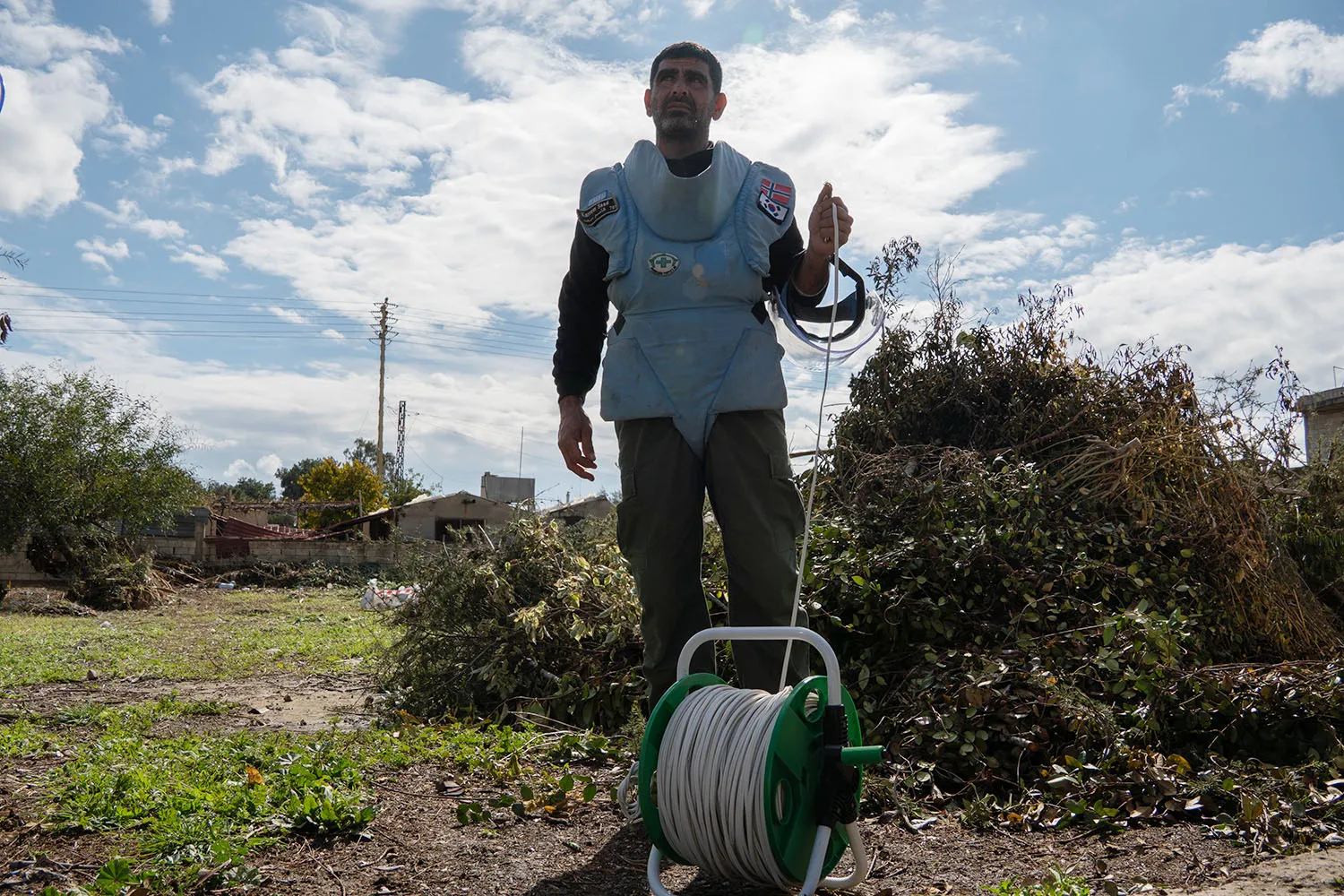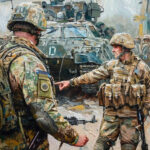Lebanon’s Demining Mission Faces Aid Uncertainty

Dispatch
Lebanon’s Demining Mission Faces Aid Uncertainty
Cuts to foreign assistance and a fragile cease-fire have made the urgent work more dangerous.
A staff member with Norwegian People’s Aid (NPA) holds a firing cable connected to an electronic detonator during demining efforts in Chabriha, Lebanon, on Feb. 12. Anagha Subhash Nair photos for Foreign Policy
TYRE DISTRICT, Lebanon—On a day in mid-February, Hasan Hamzeh walked into a cabin nestled among trees and overgrowth on a small plot of land in the Lebanese village of Chabriha. The cabin was a control point for Hamzeh’s team at Norwegian People’s Aid (NPA), which is part of active demining efforts in Lebanon following the Israel-Hezbollah cease-fire agreement.
Hamzeh, an operations manager at NPA, said that the area the team was working to decontaminate was assigned as a high-priority spot after a 15-year-old boy, Mohamed al-Mostapha, was severely injured when a hidden cluster munition left behind by either Israel or Hezbollah exploded. Al-Mostapha and his family had returned to their homes in Chabriha four days earlier, following more than 60 days of displacement.
TYRE DISTRICT, Lebanon—On a day in mid-February, Hasan Hamzeh walked into a cabin nestled among trees and overgrowth on a small plot of land in the Lebanese village of Chabriha. The cabin was a control point for Hamzeh’s team at Norwegian People’s Aid (NPA), which is part of active demining efforts in Lebanon following the Israel-Hezbollah cease-fire agreement.
Hamzeh, an operations manager at NPA, said that the area the team was working to decontaminate was assigned as a high-priority spot after a 15-year-old boy, Mohamed al-Mostapha, was severely injured when a hidden cluster munition left behind by either Israel or Hezbollah exploded. Al-Mostapha and his family had returned to their homes in Chabriha four days earlier, following more than 60 days of displacement.
Hasan Hamzeh looks toward a house in Chabriha on Feb. 12. The house is where 15-year-old Mohamed al-Mostapha was severely injured by cluster munitions.
The recent Israel-Hezbollah war caused significant devastation in Lebanon, particularly in the country’s south. According to Lebanon’s Ministry of Public Health, the latest conflict killed approximately 4,000 people and injured more than 16,000. An October 2024 report from the United Nations’ refugee agency (UNHCR) found that more than 1.2 million people were displaced from their homes. Most of the devastation took place between Sept. 17, 2024, when Israel carried out a pager explosion operation targeting Hezbollah fighters, and Nov. 27, 2024, when the fragile cease-fire deal was implemented.
Despite the cease-fire, dangers persist for those returning to their homes in the form of unexploded ordnance. U.S. limits to foreign aid funding since U.S. President Donald Trump took office in January also stand in the way of demining efforts that would allow for safe returns.
According to the Landmine and Cluster Munition Monitor, at the end of 2022, Lebanon had 16.91 square kilometers of land contaminated with antipersonnel mines and 5.23 square kilometers contaminated by cluster munitions. These are the remnants of decades of conflict, including the 15-year Lebanese civil war and multiple Israeli invasions; mines were laid in the U.N.-drawn buffer zone between Israel and Lebanon from 1984 to 2000. The extent of mine contamination has likely risen in the wake of the recent Israel-Hezbollah war.
#gallery-2 {
margin: auto;
}
#gallery-2 .gallery-item {
float: left;
margin-top: 10px;
text-align: center;
width: 100%;
}
#gallery-2 img {
border: 2px solid #cfcfcf;
}
#gallery-2 .gallery-caption {
margin-left: 0;
}
/* see gallery_shortcode() in wp-includes/media.php */
- Hamzeh points out the areas in Chabriha where the team is engaging in demining efforts on Feb. 12.
- Various sticks and items used for demarcation on the field during demining hang on a wall in Chabriha on Feb. 12.
The Lebanon Mine Action Center (LMAC), which is part of the Lebanese Armed Forces, said that more than 200,000 explosive items were found in the two months after the cease-fire took effect, including around 120 unexploded 500- or 2,000-pound bombs used by the Israeli army. LMAC oversees demining operations in the country, which is largely conducted by nongovernmental organizations (NGOs) such as NPA. Prior to engaging in operations, NPA notifies LMAC for approval, and demining activities are conducted under LMAC’s regular supervision.
“Most of the cluster munitions were found near houses, or roofs, or balconies,” Hamzeh said, explaining the dangers that unexploded ordnance poses. “Many children live in areas which were main strike sites, so sometimes they play outside their homes and start collecting scrap metal.”
All the explosive items that Hamzeh’s team found in the area between Jan. 20 and Feb. 12 were from the latest Israel-Hezbollah conflict. Wearing protective equipment, they primarily use a visual search technique, while also employing subsurface searches using metal detectors. Most items they find are MZD2s, a Chinese explosive device that both Israel and Hezbollah use. As of Feb. 12, the team had decontaminated just over 10,000 square meters and destroyed 24 items in the area.
Residents’ lack of awareness that dangers might persist in their own backyards underscores the necessity of these demining operations. Upon returning home from Beirut or the north where they were displaced, residents have no way to know for sure the extent of the fighting that took place in their neighborhood. When Hamzeh’s team worked with one resident to survey his garden, the man insisted that the area was clear, but the team found unexploded ordnance in his backyard.
NPA members work at a site in Chabriha on Feb. 12.
Lebanon is part of the U.S. Humanitarian Mine Action Program, which was established in 1996 in part to nurture peace in the Middle East and involves countries including Egypt, Iraq, and Jordan. Reeling from civil war and Israeli invasions, Lebanon formally entered the program in 1998. A 2017 U.S. State Department report notes that the United States had contributed around $60.5 million by that point to help Lebanon clear unexploded ordinances and support the LMAC.
Last year, Lebanon received $219 million from the United States Agency for International Development (USAID). Soon after Trump took office for a second term, his administration decided to suspend U.S. foreign aid—a call that could prove critical for Lebanon’s demining activities.
The LMAC said that eight of nine teams at the Mines Advisory Group, one of the NGOs it works with, were funded by USAID. Ten of the 21 teams engaging in demining operations in Lebanon had to stop working after the funding decision. (On March 5, the U.S Supreme Court mandated that the Trump administration pay $2 billion to USAID contractors, without specifying a date for the payments.)
Unexploded ordnance found in Chabriha is detonated on Feb. 12.
#gallery-4 {
margin: auto;
}
#gallery-4 .gallery-item {
float: left;
margin-top: 10px;
text-align: center;
width: 100%;
}
#gallery-4 img {
border: 2px solid #cfcfcf;
}
#gallery-4 .gallery-caption {
margin-left: 0;
}
/* see gallery_shortcode() in wp-includes/media.php */
- An NPA member holds a piece of shrapnel following the destruction of the item in Chabriha on Feb. 12.
- Unexploded ordnance found in the area is marked with tape on Feb. 12.
Joe Macaron, a researcher on U.S. and Middle East affairs at the Wilson Center, said that though assistance to Lebanon does not form a large part of the USAID budget, the foreign aid is “crucial” for Lebanon.
“In Lebanon, there are a lot of development programs, demining, municipalities, education and agricultural programs [supported by USAID],” Macaron said. “There are large numbers of staff on leave or forced to be on leave, so I think in Lebanon and the Middle East in general, everyone’s a little panicked, not understanding what’s happening.”
In the 60-day period following when the cease-fire began, the Israeli army agreed to withdraw completely from Lebanese territory, while the Lebanese army was deployed to villages in the southern part of the country. But Israel still carried out airstrikes in parts of southern Lebanon, and the Israeli army retained positions in many villages until the last few days of the cease-fire’s agreed timeline. After that period, as people tried to return home, Israeli soldiers opened fire on Lebanese citizens, killing at least 24 people and injuring 120.
This instability further impeded demining activities in southern Lebanon. Since the 60-day period ended, the Israeli army has indefinitely taken up five positions along the countries’ shared border, all of which overlook conflict zones in Lebanon or Israeli villages close to the border.
“We are usually tasked with mine and cluster munitions fields by LMAC, and for safety, we can’t deploy our teams when the Israeli army is occupying any area near contaminated areas,” Hamzeh said.
Macaron said that he thinks the aid suspension is a way for the United States to “flex their muscles a little bit, put priorities, control the mechanism of the [aid] process.” He said it is unlikely that the United States will move to stop major nonmilitary aid to the region, but that if it does, it will affect U.S. diplomatic leverage.
“[If they do it], they’re going to discover sooner or later that there’s a big impact on U.S. influence and how U.S. diplomacy functions overseas, especially in the Middle East,” Macaron said.
One of the many signs on the road between southern Lebanon and Beirut on Feb. 12. The signs warn of the dangers of unexploded ordnance.
Hamzeh reiterated the importance of demining on both a humanitarian and economic level. “If my land is contaminated by cluster munitions, and it’s not safe for me to farm on it, I’d have to wait until any organization can come and start clearance processes,” he said. “Now that America has suspended their projects, Lebanon might have to find other donors for support to clear these new cluster munitions.”
With little clarity on the future of USAID in the Middle East, multiple humanitarian programs—including demining operations in Lebanon—have slowed down or ceased. With the United Kingdom’s decision to also make cuts to global aid, the future of globally funded programs in the region amid persistent instability looks bleak. It may be time for other players to step up.
Anagha Subhash Nair is a Beirut-based multimedia journalist who reports on sociopolitical issues.
More from Foreign Policy
-

Periodic table The Periodic Table of States
The org chart for a post-Westphalian world.
-

French Emperor Napoleon Bonaparte leads the final assault by the Imperial Guard before his defeat at the Battle of Waterloo in what is today Belgium, on June 18, 1815. The Cost of Ignoring Geopolitics
Like Napoleon and the Ming dynasty, Europe is paying the price for strategic blindness.
-

Donald Trump holds solar eclipse glasses. What I Got Wrong About Trump’s Second Term
I didn’t entirely see this coming. Here’s why.
-

A woman walks past an advertisement for the Russian army at a bus stop. Russia Is Only Winning Inside Trump’s Head
As Russians will tell you, the reality on the ground looks very, very different.



















Join the Conversation
Commenting on this and other recent articles is just one benefit of a Foreign Policy subscription.
Already a subscriber?
.
Subscribe
Subscribe
View Comments
Join the Conversation
Join the conversation on this and other recent Foreign Policy articles when you subscribe now.
Subscribe
Subscribe
Not your account?
View Comments
Join the Conversation
Please follow our comment guidelines, stay on topic, and be civil, courteous, and respectful of others’ beliefs.
Change your username |
Log out
Change your username:
CANCEL
Confirm your username to get started.
The default username below has been generated using the first name and last initial on your FP subscriber account. Usernames may be updated at any time and must not contain inappropriate or offensive language.